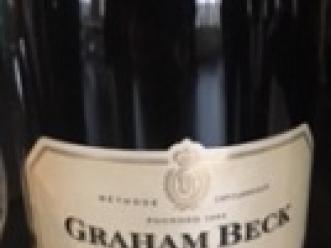Apartheid. Nelson Mandela. Zulu Kings. Wildlife Safaris. When most people think of South Africa, a variety of things come to mind, but wine usually is not one of them. Yet that’s exactly what brought me to Stellenbosch, South Africa’s premier wine appellation, earlier this year. I was curious to see what the wine industry was like in a country with such a troubling, turbulent history, an industry that is still relatively elusive to the American consumer.
The R310 thoroughfare into Stellenbosch is dotted with vineyards and boutique wineries, or wine farms as they call them in South Africa. Deep purple pinotage grapes suspend from gnarled old vines and bright yellow chenin blanc grapes shine under the heat of the red African sun. The climate is warm Mediterranean, and the cooling effects from the tall mountain range to the east of Stellenbosch, coupled with the unique convergence of two oceans, the Atlantic and the Indian, make this area prime for grape growing. Yet this is no Napa Valley; the roads aren’t littered with traffic, and the wineries of Stellenbosch, and nearby Franschoek and Paarl seem rather sleepy compared to the tourist-driven hoards of the northern California wine country. Relatively few visitors but the occasional out-of-towner hover within these tasting room walls; most South Africans eschew wine tasting for a pint in the local pub. For the few who venture out to the wineries, the result is friendly, personalized service with little if any tasting fees, and if you’re lucky, you may even be able to meet the winemaker and tour the production facilities.
With such beautiful, bucolic settings, optimal grape growing conditions, and a wine industry that dates back over three centuries (Dutch colonist Jan Van Riebeeck first brought over European vine cuttings to Constantia, the oldest wine region in South Africa, in the late 17th century), it is surprising that the South Africa hasn’t become the hot new wine destination.
Of course there is the wine to consider. With the majority of South Africans still preferring beer to wine, and the South African wine industry getting little recognition elsewhere in the world, where it is continually overshadowed by the giants of France, Italy, the U.S., and even Australia, which has less area under vine than South Africa, but has still managed to compete with the big boys of the wine world, one has to ask if South African wine is worthy of international fame. Despite its fairytale like vineyards, and its massive output of wine (it’s the 9th largest wine producer in the world), South Africa’s wine industry is still very insular. While chatting with a young woman pouring wine at one of the most established family owned wineries in Stellenbosch, I was surprised to learn that she had only once tasted a wine from outside of South Africa. “It was a special treat,” she said. “The winemaker brought it back from one of her trips to France. But most of the time it’s nearly impossible to find wines that weren’t made here.” She wasn’t kidding. Every restaurant menu I perused, every grocery store wine shelf, even the specialty wine shops in the major cities were stocked with nothing but South African wines. Trade sanctions have been lifted since the end of apartheid, making it possible for international wines to be exported to South Africa and vice-versa, but the availability of wines there remains exclusively South African. While I’m not advocating that South Africa try to emulate the style of other regions’ wines, or that they turn their back on the local products in exchange for imported wines, I think that an awareness of what other wines are on the international market could lead to improvements in overall quality and marketability of the wines of their homeland.
Other factors worth examining in the quality and marketability debate over South African wines include the prevalence of cooperatives and the types of wines being produced. For a long time, the South African wine industry was dominated by one large cooperative, the KWV (Ko-operatieve Wijnbouwers Vereniging van Zuid-Afrika). The KWV has lost its stronghold on the industry, but co-ops are still abundant, and though they frequently produce large quantities of wine, it is not always of the best quality. Finally, there are grape varieties to consider. Chenin blanc is the most widely planted grape variety in South Africa, and while it is often made into stunning wines in the Loire Valley in France, the majority of South African chenins I tried were either insipidly bland, or so overly oaked that they masked the true flavor of the grape. South Africa’s native grape, pinotage, a crossing of pinot noir and cinsault can produce unique, good quality wines, but when proper attention is not paid to it in the winemaking process, it can be thin and acidic, and give off unpleasant flavors of bubblegum and cheap cherry candy, reminiscent of a poorly made Beaujolais.
The good news is that things are moving forward. Producers are beginning to focus on quality rather than quantity. Enthusiastic young winemakers are working harvests in the Northern Hemisphere during the South African winter, and bringing back with them innovative methods of production. Cape blends that mix pinotage with sturdier varieties such as cabernet sauvignon and merlot are becoming popular. Shiraz and sauvignon blanc are also beginning to make a name for themselves, getting more and more acknowledgement from internationally acclaimed wine reviewers. In addition to the already well-established wine regions of Stellenbosch, Constantia, Franschoek, and Paarl, new designated wine appellations are springing up all over South Africa. And perhaps the best thing for the international consumer is that the wines of highest quality are generally exported in an effort to gain recognition in the worldwide wine market. Though it may take awhile, I am certain that over the next decade, South African wines will make their way into realm of world-class wines.





